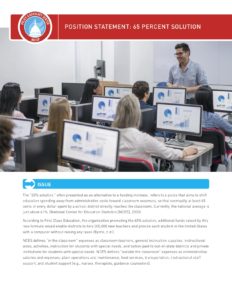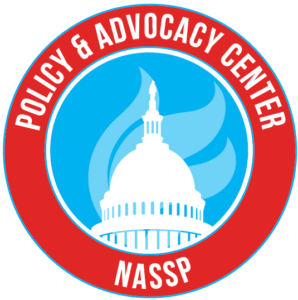The “65% solution,” often presented as an alternative to a funding increase, refers to a policy that aims to shift education spending away from administrative costs toward classroom expenses, so that eventually at least 65 cents of every dollar spent by a school district directly reaches the classroom. Currently, the national average is just above 61%. (National Center for Education Statistics [NCES], 2003).
According to First Class Education, the organization promoting the 65% solution, additional funds raised by this new formula would enable districts to hire 300,000 new teachers and provide each student in the United States with a computer without raising any taxes (Byrne, n.d.).
NCES defines “in the classroom” expenses as classroom teachers, general instruction supplies, instructional aides, activities, instruction for students with special needs, and tuition paid to out-of-state districts and private institutions for students with special needs. NCES defines “outside the classroom” expenses as administrative salaries and expenses, plant operations and maintenance, food services, transportation, instructional staff support, and student support (e.g., nurses, therapists, guidance counselors).
At this time, three states have adopted the measure (Kansas, Louisiana, and Texas) and more states are considering similar legislation, including Arizona, Colorado, Florida, Illinois, Minnesota, Ohio, and Washington. The U.S. public seems to favor this policy. A Harris Interactive Poll shows 70% to 80% of respondents favor its implementation.
Proponents believe there is a correlation between states’ average funding formula and student standardized test scores. The top five states place the highest percentage in the classroom (average 64.2%) and the bottom five states place the lowest percentage in the classroom (average 59.46%).
Opponents of the plan, including the American Enterprise Institute (Hess, 2006) and the American Association of School Administrators (n.d.), argue that research simply does not support the 65% solution. Standard and Poor’s (S&P) conducted an analysis of district-level spending and student achievement data and concluded that there is no consistent relationship between the two factors. According to S&P (2005), “The specific ways that school districts use their instructional dollars may have as much, if not more, of an impact on student achievement as the percentage of dollars spent in the classroom.”
S&P (2005) also analyzed data in nine states that are currently considering the 65% solution and concluded that there is “no significant positive correlation between the percentage of funds that districts spend on instruction and the percentage of students who score proficient or higher on state reading and math tests.”
Finally, opponents object to an input-driven initiative without measurable outcomes and question a one-size-fits-all solution that ignores the complexities of education funding.
Guiding Principles
- NASSP supports research-backed practices and policies that will make a difference in student learning.
- NASSP believes that local districts, which are held accountable for student achievement, should also have the authority to decide how education funds are allocated.
- NASSP believes, and recent research has confirmed, that school leadership affects student achievement (second only to instruction, particularly for at-risk students).
- NASSP believes that the NCES expense categories in the classroom and out of the classroom both affect student learning, albeit in different ways. Even though administrators’ salaries are categorized as out of the classroom expenses, leadership is now known to affect student achievement in a significant way.
- NASSP advocates for better use of funds but also believes that education funding has suffered grave losses in the past few years.
- NASSP believes that in education policy, a one-size-fits-all approach is too simplistic and can lead to negative consequences.
Recommendations
NASSP calls on policymakers to:
- Collect data and conduct rigorous research in states and districts that have adopted the 65% solution policy to analyze the effect of the law on student progress.
- Oppose any efforts to pass legislation that aims to simply reallocate funding from one category to another.
- Provide flexibility in funding allocations, as long as accountability systems are in place and desired results are achieved, including equal opportunities for all students to learn and grow.
- Recognize that so-called administrative expenses sometimes include essential categories of personnel—such as special education teachers, when they are assigned to more than one school—and administrators, whose influence on student achievement has been demonstrated by research.
- Encourage districts to adopt a transparent reporting system that explains to the community how public money is spent and what measurable outcomes resulted from the investment.
- Commit to education funding as a sound investment into the future of the United States.
References
American Association of School Administrators. (n.d.). AASA’s position statement on the 65 percent rule. Retrieved from www.aasa.org/edissues
Byrne, P. M. (n.d.). America’s classrooms, teachers & students come first with the 65% solution. Retrieved from www.firstclasseducation.org
Hess, F. (2006, February 22). The 65 percent solution. The Washington Times. Retrieved from www.aie.org/publications
National Center for Education Statistics. (2003). Financial accounting for local and state school systems. Washington, DC: Author.


